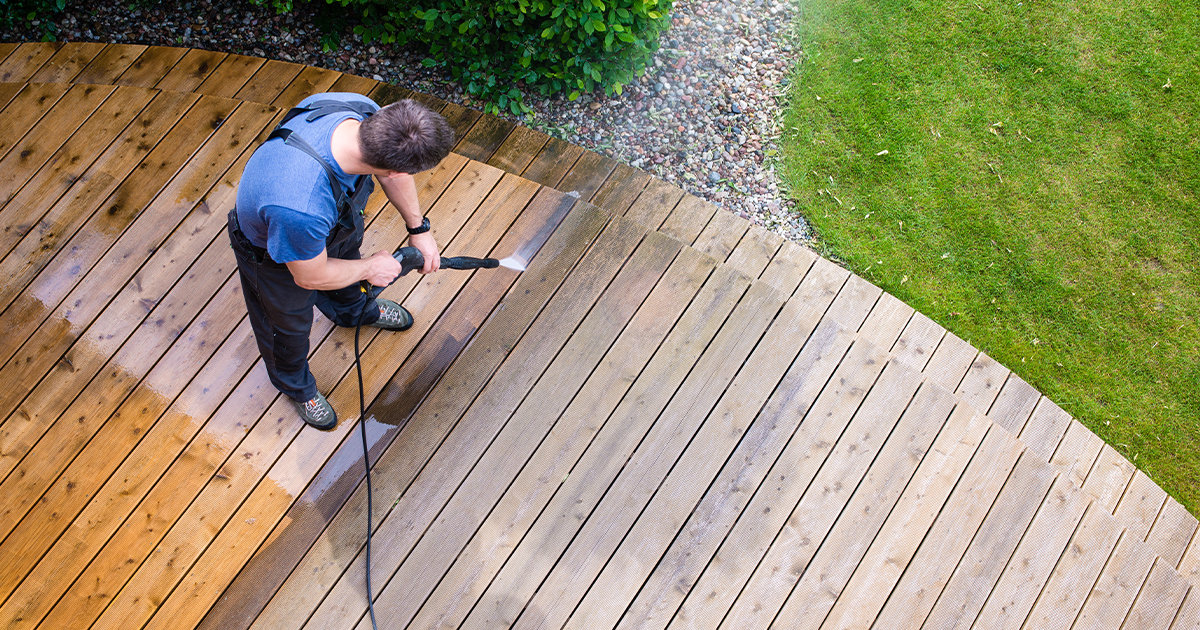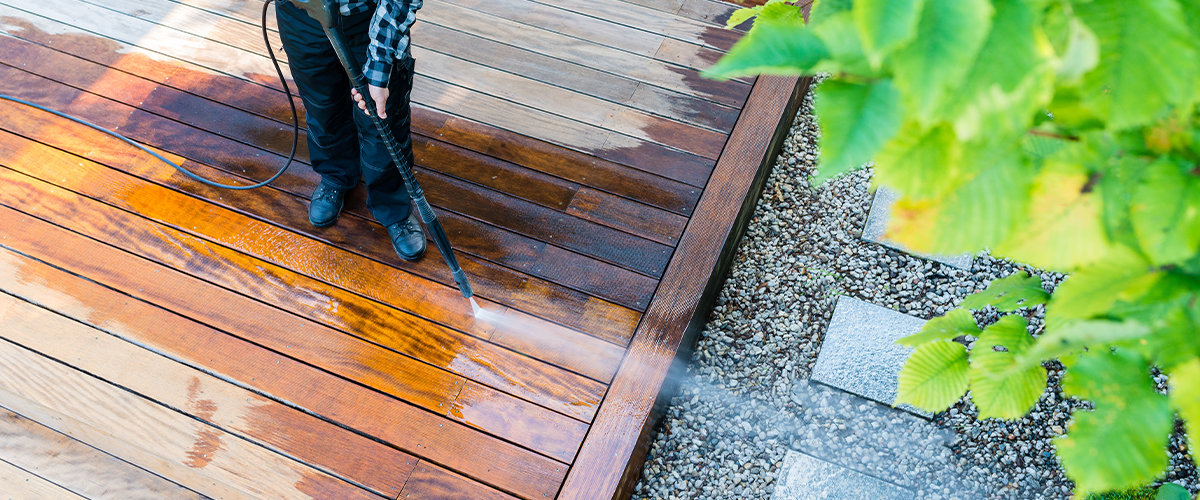
We collect basic website visitor information on this website and store it in cookies. We also utilize Google Analytics to track page view information to assist us in improving our website.
Spring Season starting to book up. Promotions Available for Winter.

Having a backyard deck is a huge benefit to an outdoor space. It’s a place to go out and relax, socialize with friends and family, and host summer barbeques and weekend get-togethers. But like any aspect of homeownership, there’s maintenance and cleaning involved if you want to keep your deck looking fresh and presentable.
It can be difficult to know what method is the best one to use when cleaning your deck, however. Power washing is a popular and effective way to blast away dirt and debris, but is it the right choice for your deck?
Check out the tips below to see if power washing is the ideal way you should be keeping your deck clean, and the tips to consider if you do!
Power washing can be an excellent time-saver, while safely deep cleaning and removing dirt.
Using this method opens the pores of the wood and allows deeper penetration of the deck’s stain or finish. Power washing is better at getting rid of embedded dirt, chemicals, staining, and discolouration than simply using a garden hose and unpressurized, plain water. As well, it’s also a good option for stripping old finishes and peeling paint.
However, it’s important to keep in mind that power washing is not a gentle or light way to clean your deck. It’s harsh, and it needs to be used on the right surfaces, with the proper form for it to be effective without causing any lasting damage–which is the opposite of what you want to happen when trying to keep something clean.
Decks made from high-end, cap stock decking material are more likely to withstand power washing without any problems. Wood and composite decks can handle power washing, but it’s best to choose a professional to do it if that’s the material your deck is made from. It’s important to select someone who specializes in deck power washing specifically, to ensure they know exactly how to clean your deck in the best way.
You shouldn’t need to rely on power washing too frequently to maintain your deck’s cleanliness. As long as you stay on top of basic deck upkeep throughout the changing seasons, power washing shouldn’t need to be done more than once a year.
As discussed above, power washing is not a delicate way to clean your deck.
You need to be mindful of the risks, and decide whether or not you have the proper time, the right supplies, enough investment, and adequate knowledge to power wash your deck correctly.
Power washing makes the surface of a deck wet, raising wood fibres and creating roughness. This can be worsened when these elevated fibres lead to splinters, requiring you to sand your deck if power washing has caused this problem to occur. As well, power washing can cause the deck’s stain to be pulled off completely, and if this wasn’t the goal you intended to reach, you will need to reapply the stain afterwards to achieve the same look again. The same can be said for paint–power washing will strip it away completely and you’ll need to embark on a potentially costly and timely endeavour to repaint your deck if power washing strips it away.
As well, it’s necessary to be mindful of the chemicals being used to power wash your deck. To maintain the highest level of cleanliness, power washing typically incorporates the usage of chemicals. Power washing can, unfortunately, redirect these chemicals onto surrounding flowers, grass, and shrubs, causing them to wither and dry up.
It’s not advised to power wash your deck in a rush, with the improper water pressure, wrong form, or to do so repeatedly on a deck that has already been power washed recently. Be mindful of your deck’s material, and get advice from an expert if you’re still unsure about the risks associated with power washing. Going against advice can cause irreversible damage, and it’s important to know what you’re doing before you get started.
The right nozzle can make all the difference in the state of cleanliness and damage risk associated with power washing your deck.
Damage can easily happen if you choose the incorrect tip. A fan or brush-style nozzle is always the better choice for wood staining projects specifically.
Jet-style tips with narrow spray patterns should never be chosen to power wash your deck. Using them can cause significant damage to the wood, and create striped, path-like marks along the boards that can’t be removed without re-staining.
If you’re choosing to do it yourself, it is incredibly important to execute the right form when power washing to reduce the risk of ruining your deck.

To avoid making any regrettable mistakes, make sure you’re using a broad, sweeping motion when washing. Direct the water at a low angle to the surface, and keep the nozzle in motion at all times. Go at a moderate pace, with a side-to-side motion.
You might think that if you just constructed your deck, the wood will be clean enough that you won’t need to power wash it.
However, you will notice that deck stain won’t colour your deck evenly, penetrate at all and sit on top of the deck’s surface like paint, and will not provide the intended full protective benefits. If it isn’t absorbed properly, the wood stain will flake and peel off.
If your deck has been recently sanded, all you will need is plain water and low pressure to properly power wash it.
Decks require a specific kind of cleaning product to be power washed correctly.
Choose a high-rated cleaner that is designed for deck cleaning, and apply it evenly to all of the surfaces that will be power washed. Read instructions thoroughly to make sure you’re getting the most out of your cleaner.
Along with the nozzle, the correct pressure is essential in preventing damage to your deck from happening.
Be mindful, and set your power washer at a low or medium setting while washing. High-pressure settings increase the possibility of damaging the wood of your deck and creating irreversible marks that can’t be covered up with staining.
Never position the nozzle of your power washer right against the surface of your deck. Always leave enough space between the tip and the wood. The closer the nozzle of the washer is to the deck itself, the larger the risk is of the water leaving permanent, imprinted lines. Pull back to allow for even and thorough cleaning distribution.
If you’re planning on power washing your deck, it’s essential to make sure the space is clear.
Move aside any outdoor furniture, plants, or items that would be in the way of cleaning. To clean properly, there need to be no obstacles in the way of the power washer to ensure even water distribution or unnecessary displacement of chemicals.
One of the most important things you can do is to maintain your deck’s cleanliness regularly. Make it a goal to keep it tidy and well-kept to take away the need for intense cleaning measures like power washing.
The basic deck cleaning materials you’ll need are a broom and dustpan, hose, bristle brush, biodegradable cleaning solution, dish soap or powdered laundry detergent mixed with water.
Move aside outdoor furniture, and routinely sweep up any dirt and debris like fallen leaves. Test an area of your deck with your desired cleaning product and water to make sure it doesn’t stain and use your bristle brush to scrub away any embedded dirt and residue.
After you’re done, thoroughly rinse your deck and allow it to dry before moving your furniture and deck items back to their original spots.
When thinking about power washing your deck, make sure you consider the pros and cons before you start to protect it from any potential damage and follow these tips to get the most out of your cleaning.

